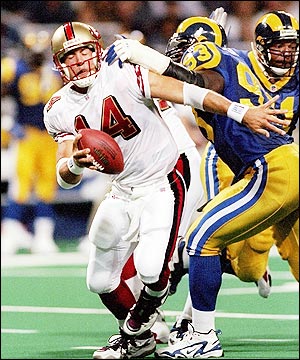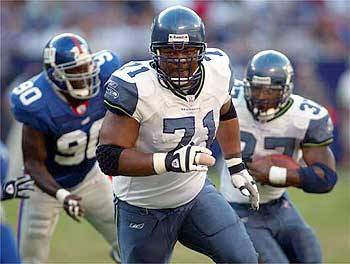@HighwayToHall
It was recently reported that former Seattle Seahawks left tackle Walter Jones will be eligible for the NFL Hall of Fame in 2014, a year earlier than anticipated. Although Jones retired following the 2009 season, he spent that entire season on injured reserve. So the Hall determined his 5-year waiting period should start a year earlier. As mentioned in our preview of the Class of 2014, we reserved the right to amend our predictions if it was determined that Jones was in fact eligible. Let’s go ahead and do that now, beginning with Walter Jones’ unusual journey to the NFL.
Jones
didn’t begin playing football until the 9th grade. Poor grades led
him to Holmes (Miss.) Community College where he played two years before
transferring to Florida State in 1995. He redshirted his first season then
played one season for the Seminoles, a season in which he allowed only one sack
and was called for one penalty. He was named 2nd Team All-ACC behind
Clemson’s Jim Bundren and Georgia Tech’s Curtis McGee. After that one season, Jones
decided to turn professional, a surprise to many. According to then Tampa Bay
Buccaneers director of college scouting Tim Ruskell, “We didn’t really know
that much about him because he didn’t play the year before. He came out of
nowhere almost because we weren’t looking at him.”[1]
Measuring
6’5 and 301 pounds, Jones turned heads when he ran a 4.65 40 yard dash. Teams
marveled at his athletic ability. One
scout said, "Walter Jones
is the most intriguing player in this draft, as rare a player at his position
in about 10 years. He is a combination of massive size and marvelous
speed."[2] Another
scout added, "He's my favorite player in the draft. When all is said and
done, this guy will be a better player than [Orlando] Pace."[3]
Not every scout agreed. While no one
could deny his athletic prowess, some teams were scared by his lack of experience.
According to one scout, "One year of major-college
football and he's going to line up in the NFL? It's going to be a shock when he
gets power rushed or lines up against bigger guys. He's a young, immature guy
right now with great physical tools.”[4]
While Jones was rocketing up draft
boards, teams were playing Let’s Make a Deal. By the time the NFL Draft rolled
around, the draft order bore little resemblance to what it did initially:
Initial Draft Order
|
|
1
|
New York Jets
|
2
|
New Orleans Saints
|
3
|
Atlanta Falcons
|
4
|
Baltimore Ravens
|
5
|
Detroit Lions
|
6
|
St. Louis Rams
|
7
|
New York Giants
|
8
|
Tampa Bay Buccaneers
|
9
|
Arizona Cardinals
|
10
|
Oakland Raiders
|
Final
Draft Order
|
|
1
|
St. Louis Rams
|
2
|
Oakland Raiders
|
3
|
Seattle Seahawks
|
4
|
Baltimore Ravens
|
5
|
Detroit Lions
|
6
|
Seattle Seahawks
|
7
|
New York Giants
|
8
|
New York Jets
|
9
|
Arizona Cardinals
|
10
|
New Orleans Saints
|
Then
New York Jets head coach Bill Parcells held all of the cards entering the
draft. Ohio State offensive tackle Orlando Pace was the most coveted player in
a weak draft. How weak? See the list of the quarterbacks selected, shown in the
order in which they were drafted:
Jim Druckenmiller
|
Virginia Tech
|
Jake Plummer
|
Arizona State
|
Danny Wuerffel
|
Florida
|
Pat Barnes
|
California
|
Mike Cherry
|
Murray State
|
Chuck Clements
|
Houston
|
Tony Graziani
|
Oregon
|
Koy Detmer
|
Colorado
|
Wally Richardson
|
Penn St.
|
Tony Corbin
|
Cal State-Sacramento
|
Ron McAda
|
Army
|
According
to then San Francisco 49ers player personnel director Vinny Cerrato, ''It's a
so-so draft. There are seven, maybe eight, top-notch picks. After that, it's
what you're looking for. You can get rich with a bunch of No. 2s…There's
quantity, not quality. We could easily take the same guy at 10 as we do at 26.
That's how crazy it could be.”[5]
Parcells,
looking for a defensive player, actively shopped the number 1 pick, before
finding a taker in the St. Louis Rams, who ultimately selected Pace. The Jets
settled in at #8 and selected 2-time Pro Bowl linebacker James Farrior from
Virginia.
The
Raiders, picking second after a trade with the Saints, selected USC defensive
tackle Darrell Russell. The Seahawks were then on the clock.
Seattle
had traded Rick Mirer and a 4th Round Pick (#105-Darnell Autry) to
the Chicago Bears in exchange for the Bears 1st Round Pick (#11).
The Seahawks then traded the #11 pick, a 2nd Round Pick (#41-Byron
Hanspard), a Third Round Pick (#70-OJ Santiago), a 4th Round Pick (#100-Henri
Crockett) to the Falcons in exchange for Atlanta’s 1st Round Pick
(#3) and a third round pick (#63).
With
the #3 pick, the Seahawks drafted Ohio State cornerback Shawn Springs. But they
were not done. The Seahawks then traded the #12 pick and the #63 third round
pick acquired from the Falcons to Tampa for the Bucs’ #6 pick. After the Ravens
drafted Florida State defensive end Peter Boulware and the Lions chose Texas
cornerback Bryant Westbrook, the Seahawks drafted Walter Jones, while the Bucs
acquired Florida State running back Warrick Dunn and Auburn guard Frank
Middleton.
After
a lengthy holdout, Jones signed a 6-year/$12 million contract with a $4 million
signing bonus.
With
2 preseason games under his belt, Jones was named the starting left tackle for
the season opener, a 41-3 drubbing at home by the Jets, a team that finished
1-15 the previous year. Things got better for the Seahawks, however, and they
finished the season 8-8. Despite being hobbled for much of the season by ankle
sprains, ultimately causing him to miss 4 games, Jones was named to the NFL
All-Rookie team, joining Green Bay’s Ross Verba at the tackle position.
1998
featured more of the same for the Seahawks, who again finished 8-8. But they
finally got over the hump in 1999, finishing 9-7 and reaching the playoffs for
the first time since 1988. Jones was named to his first Pro Bowl.
In
2000, Seattle took a step backwards, finishing 6-10. The Seahawks were left out
of the Pro Bowl for the first time in 20 years.
Beginning
in 2001, Seattle’s fortunes changed. They traded their 1st Round
pick (#10) and 3rd Round pick (#72) to Green Bay for quarterback Matt
Hasselbeck and their 1st Round pick (#17).[6]
With the #17 pick, Seattle selected 7-time Pro Bowl guard Steve Hutchinson from
Michigan, who teamed with Jones to form one of the most dominant offensive line
tandems in history, opening holes for running back Shaun Alexander, who was
inserted into the starting lineup that season.
Seattle finished the 2001 season 9-7, and Jones was selected to the first of 8 consecutive Pro Bowls.
Seattle
finished 7-9 in 2002, but when Hasselbeck became the full-time starting
quarterback in 2003, the Seahawks soared, making 5 consecutive playoff
appearances and winning 4 division titles and an NFC Championship
between 2003 and 2007. Walter Jones was the cornerstone of the franchise during
this era, paving the way for several record-breaking Alexander seasons. Head
coach Mike Holmgren described him as the best offensive player he ever coached,
a list which includes Brett Favre, Joe Montana, Steve Young and Jerry Rice.[7]
Upon
his retirement, his jersey #71 was immediately retired, and Washington Governor
Chris Gregoire declared April 30 “Walter Jones Day.”
Jones
played in a strong era for offensive tackles. Anthony Munoz retired in 1992.
Gary Zimmerman retired in 1997. At that time, these men took over:
Richmond Webb
|
1990-2002
|
Erik Williams
|
1991-2001
|
Willie Roaf
|
1993-2005
|
Tony Boselli
|
1995-2001
|
Jonathan Ogden
|
1996-2007
|
Willie Anderson
|
1996-2008
|
Walter Jones
|
1997-2008
|
Orlando Pace
|
1997-2009
|
With
these men playing at the same time, there were not a lot of All-Pro spots
available. Things were further complicated when Larry Allen spent time at
tackle and took post-season honors away from some of these players.
Nonetheless,
Walter Jones was selected to 9 Pro Bowls, named a 1st Team All-Pro 4
times, and named a 2nd Team All-Pro twice. He was chosen a 1st
team member of the All-Decade Team of the 2000s alongside 2013 Hall of Fame selection
Jonathan Ogden. He helped the Seahawks to 6 playoff appearances, spending his
entire career with the club, appearing in 180 regular season games.
His
accolades place him in some exclusive company. Here is a list of offensive
linemen with 8+ Pro Bowls and 4+ 1st Team All-Pro selections:
Jim
Otto
|
Lou
Creekmur
|
Ron
Mix
|
Alan
Faneca
|
Anthony
Munoz
|
Jim
Ringo
|
Jim
Parker
|
Jim
Tyrer
|
Forrest
Gregg
|
Billy
Shaw
|
John
Hannah
|
Mike
Webster
|
Bruce
Matthews
|
Lou
Groza
|
Randall
McDaniel
|
Walter
Jones
|
Larry
Allen
|
Jonathan
Ogden
|
Roosevelt
Brown
|
Let’s
look at one more list, offensive linemen with 4+ 1st Team All-Pro
selections since the 1970 AFL-NFL merger:
Anthony
Munoz
|
Dermontti
Dawson
|
Mike
Webster
|
John
Hannah
|
Alan
Faneca
|
Walter
Jones
|
Bruce
Matthews
|
Ron
Yary
|
Jim
Langer
|
Randall
McDaniel
|
Steve
Hutchinson
|
Jonathan
Ogden
|
Larry
Allen
|
Larry
Little
|
Dwight
Stephenson
|
This
list is comprised of 15 men. 12 are current Hall of Famers, 2 players are not
yet eligible, and Mr. Jones.
Walter
Jones stands among the all-time greats. Despite playing during a wonderful era
of offensive tackles, Jones collected enough accolades to join some exclusive
company. He consistently erased the opponent’s top pass rusher while opening
gaping holes for Shaun Alexander. Like Larry Allen and Jonathan Ogden last
year, Jones will be a first-ballot Hall of Famer. The only suspense remains who
joins him.
As
we explained in a previous post, Marvin Harrison and Derrick Brooks are also
first-ballot Hall of Famers, leaving Michael Strahan and Charles Haley as the
final two selections. Aeneas Williams falls off our previous prediction.
[1]Landman,
Brian. “FSU tackle Jones is big man on the block.” St. Petersburg Times. 14 Apr. 1997. 1C. Print.
[2]
McGinn, Bob. “NFL DRAFT: OFFENSIVE LINE – Florida State tackles moves to head
of the class – Scouts rank Jones ahead of Ohio State’s Pace.” Milwaukee Journal Sentinel. 14 Apr. 1997.
C. Print.
[3] Id.
[4] Id.
[5]
Judge, Clark. “NFL draft thin on top, receding after early picks.” San Jose Mercury News. 6 Apr. 1997. 1D.
Print.
[6]
Green Bay selected Florida State defensive end Jamal Reynolds (#10) and
Oklahoma linebacker Torrance Marshall (#72).
[7] Williams,
Eric D. “On the field, few kept up with Jones.” The News Tribune (Tacoma, WA). 30 Apr. 2010. B1. Print.






